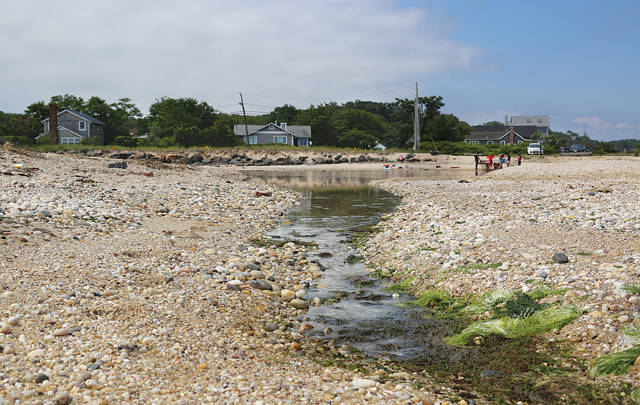As Goldsmith Inlet situation worsens, town pressures county to dredge


Just before 11 a.m. last Wednesday — two hours before low tide — Goldsmith Inlet was already sealed shut by sand. The winding waterway in Peconic had slowed to a trickle, then vanished into a line of sand blocking the tepid water.
Town engineer Michael Collins pointed to Long Island Sound beyond and laid out the consequences of a little extra sand.
The water in Goldsmith Inlet can’t connect to the Sound, so the inlet can’t be flushed with seawater. This causes water quality to suffer.
Fish can’t swim into the inlet and the eels that reside there won’t be able to leave to breed when mating season comes.
Nearby Autumn Pond can’t drain into the inlet through an underground pipe because the water is trapped in the inlet. This is causing the water level in the pond to rise high enough that it reaches nearby houses’ septic systems, exposing the water to potential bacterial contamination.
In short, according to Mr. Collins, Goldsmith Inlet — the problematic waterway that has been the subject of ongoing controversy about ways to protect it — is once again in trouble. And as the tide lowers, things will only get worse.
Town officials, homeowners and neighbors say the inlet must be dredged soon.
“It is really serious,” said Southold Town Trustee John Bredemeyer said at last Tuesday morning’s Town Board work session.
Supervisor Scott Russell said the town has received a letter from nearby homeowners who are “somewhat alarmed by it.”
“They’re saying the pond is dying,” Mr. Russell said. The town, he added, will have to enlist the help of Suffolk County’s Department of Public Works to dredge the inlet to remove the blockages.
While the town conducts its own annual dredging at the inlet, Mr. Collins said, that work is limited to an area its mouth. The county would be able to dredge the entire waterway, removing enough sand and silt to improve conditions in a meaningful way, he said.
And since Suffolk owns land on either side of the inlet, Mr. Russell said, it’s the county’s responsibility to care for it. He said he has spoken to county representatives about dredging the waterway quickly.
“Suffolk County has an obligation to protect their asset,” he said. “They recognize the necessity to keep dredging.”
Goldsmith Inlet dates back to at least the 1700s and was the site of a mill in the mid-1800s. The channel — which at the time was deep enough to allow powered boats — later served as a base for rum running during Prohibition.
Problems began after 1963, when Suffolk County paid just over $134,000 to build a jetty on the western side of the channel, which started funneling sand into the inlet.
By the late 1980s, the inlet had not only been added to the town’s list of “critical and essential” dredging sites, but had risen to the top of the list, according to previous Suffolk Times coverage. In 1990, the state Department of Environmental Conservation followed suit, declaring the inlet a “critical environmental area.”
The town began dredging the inlet annually starting in 2006, after a county dredging project the previous year was less effective than authorities had hoped.
“The problem is, we can dredge and the dredging might last for the season,” Mr. Russell said. “But we can’t keep going back and dredging.”
Mr. Collins said the town didn’t dredge the inlet last fall because indicators at the site showed it wasn’t necessary. But a sudden change at the inlet months later worsened conditions dramatically — long after the official dredging season ended in January.
“The difference in the past few weeks is devastating,” one neighbor wrote in an email to the town. “The sand has formed a total blockade of the inlet. There is a green slime on top of the stagnant water. The fish, crabs and water life are dying a slow death.”
The county has a committee that must approve all dredging projects; town officials said the only criteria that would apply is an environmental consideration for the health of the waterway.
“We’re asking the county to place it back on the dredge priority list,” Mr. Russell said. As a backup plan, the supervisor said his preliminary proposed budget for next year will include money to cover a town dredging of the inlet.
But the county health department’s testing of the area showed the waterway as healthy, though that was before it was sealed shut. Town Board member William Ruland said the process was “moving forward, albeit slowly.”
“They have to recognize that if you wait until you create your own crisis, common sense asks why you would do that,” he said.
Mr. Ruland said the board should continue to put pressure on the health department to dredge the inlet quickly.
“Unfortunately, it seems pressure is the only thing the health department responds to in these instances,” he said.
Photo: Goldsmith Inlet — the problematic waterway that has been the subject of ongoing controversy about ways to protect it — is once again in trouble. (Credit: Paul Squire)








